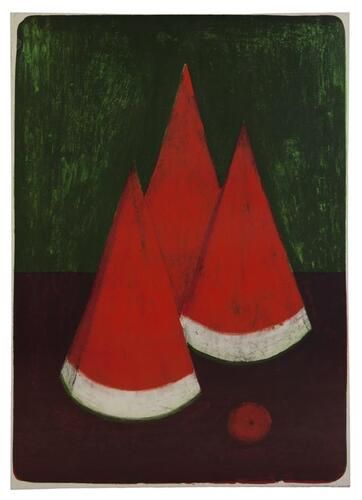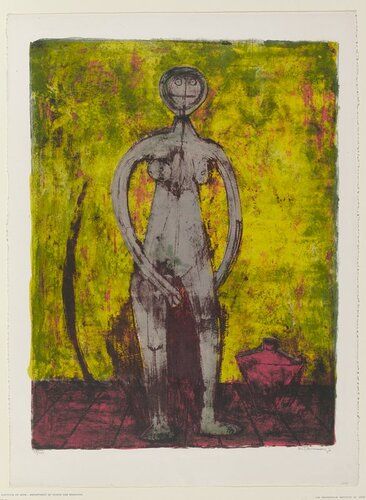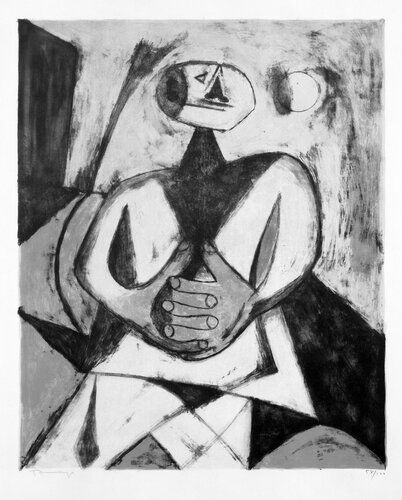
Nina a la puerta
Nina a la puerta https://collections.artsmia.org/art/55494/
15.11.2025 17:30 — 👍 1 🔁 0 💬 0 📌 0@rufinotamayo.bsky.social
Fan account of Rufino Tamayo, a Mexican painter of Zapotec heritage, known for painting figurative abstraction with surrealist influences. 1899-1991 Automated thanks to @andreitr.bsky.social and @botfrens.bsky.social

Nina a la puerta
Nina a la puerta https://collections.artsmia.org/art/55494/
15.11.2025 17:30 — 👍 1 🔁 0 💬 0 📌 0
© D.R. Rufino Tamayo / Herederos / México. Fundación Olga y Rufino Tamayo, A.C.
Watermelon https://www.brooklynmuseum.org/opencollection/objects/103812
15.11.2025 09:54 — 👍 1 🔁 0 💬 0 📌 0
Harvard Art Museums/Fogg Museum, Gift of Mr. and Mrs. Harold Gershinowitz © Rufino Tamayo / Artists Rights Society (ARS), New York
Man Searching the Heavens https://www.harvardartmuseums.org/collections/object/227875
14.11.2025 15:54 — 👍 1 🔁 0 💬 0 📌 0
Watermelons
Watermelons https://www.wikiart.org/en/rufino-tamayo/watermelons-1977
14.11.2025 12:08 — 👍 0 🔁 1 💬 0 📌 0
Gift of Mrs. Henry T. Ricketts
Woman in Mauve https://www.artic.edu/artworks/34681/
13.11.2025 18:58 — 👍 1 🔁 0 💬 0 📌 0
Watermelons
Watermelons https://www.wikiart.org/en/rufino-tamayo/watermelons
13.11.2025 08:52 — 👍 0 🔁 0 💬 0 📌 0
Friend of the Birds
Friend of the Birds https://www.wikiart.org/en/rufino-tamayo/friend-of-the-birds-1944
12.11.2025 16:45 — 👍 1 🔁 1 💬 0 📌 0
Rufino Tamayo tried to move past the nationalist themes favored by the generation of Mexican artists that preceded him and toward more universal ones. While working in France in 1959, he produced a series of lithographs illustrating the chapters of the New Testament book of Revelation, Saint John the Divine’s vision of things to come. Included were images of the Four Horseman of the Apocalypse: Conquest, War, Famine, and Death. Death is front and center here. "I looked, and there before me was a pale horse! Its rider was named Death, and Hades was following close behind him. They were given power over a fourth of the earth to kill by sword, famine and plague, and by the wild beasts of the earth." (Revelation 6:8) Death displays consummate horsemanship, riding without saddle or reins, but his steed seems a little spooked. Perhaps Hades is gaining on them'
Death on a Pale Horse, from Apocalypse of Saint John https://collections.artsmia.org/art/44282/
12.11.2025 12:46 — 👍 1 🔁 0 💬 0 📌 0
abstracted landscape; red-brown mountina shape with lines, "cracks"; mottled blue-black sky; pale yellow moon orb Rufino Tamayo was a leading 20th-century Latin American paintner and printmaker who was active both in Mexico and the United States. During the 1940s, he worked with Stanley Hayter at the celebrated print workshop Atelier 17, then located in New York City. He pursued traditional subjects in his art, typically avoiding the leftist political content found in the work of many of his fellow Mexican artists. He produced this austere nocturnal landscape using the intaglio process of mixografia, a three-dimensional printing technique he helped invent. It was developed to capture textures and surface details more commonly seen in painting, collage, or bas-relief. The labor-intensive process requires a high-pressure printing press to simultaneously emboss thick handmade paper and transfer one or more colors.
Paisaje con luna https://collections.artsmia.org/art/43989/
11.11.2025 19:35 — 👍 3 🔁 1 💬 0 📌 0
Print and Drawing Club Fund
Two Women https://www.artic.edu/artworks/77059/
11.11.2025 09:38 — 👍 1 🔁 0 💬 0 📌 0
Gift of Kleiner, Bell & Co.
Man at the Door http://www.moma.org/collection/works/76865
10.11.2025 16:08 — 👍 1 🔁 0 💬 0 📌 0
Print and Drawing Club Fund
Coyote https://www.artic.edu/artworks/77063/
10.11.2025 13:52 — 👍 1 🔁 1 💬 0 📌 0
Inter-American Fund
Man, Moon and Stars http://www.moma.org/collection/works/68273
09.11.2025 16:00 — 👍 0 🔁 0 💬 0 📌 0
Gift of Kleiner, Bell & Co.
Profile of a Man http://www.moma.org/collection/works/76844
09.11.2025 13:26 — 👍 0 🔁 0 💬 0 📌 0
Print and Drawing Club Fund
Untitled https://www.artic.edu/artworks/77061/
08.11.2025 17:06 — 👍 1 🔁 0 💬 0 📌 0
Desnudo en gris
Desnudo en gris https://collections.artsmia.org/art/55496/
08.11.2025 11:40 — 👍 0 🔁 0 💬 0 📌 0
© D.R. Rufino Tamayo / Herederos / México. Fundación Olga y Rufino Tamayo, A.C.
Man With Hands Clasped https://www.brooklynmuseum.org/opencollection/objects/64970
07.11.2025 19:47 — 👍 1 🔁 0 💬 0 📌 0
© D.R. Rufino Tamayo / Herederos / México. Fundación Olga y Rufino Tamayo, A.C.
Woman Standing Beside Table https://www.brooklynmuseum.org/opencollection/objects/71141
07.11.2025 10:38 — 👍 0 🔁 0 💬 0 📌 0
Gift of Kleiner, Bell & Co.
Man at the Door http://www.moma.org/collection/works/76865
06.11.2025 18:01 — 👍 1 🔁 0 💬 0 📌 0
Mujer en gris
Mujer en gris https://www.wikiart.org/en/rufino-tamayo/mujer-en-gris-1931
06.11.2025 10:41 — 👍 1 🔁 0 💬 0 📌 0
Watermelons
Watermelons https://www.wikiart.org/en/rufino-tamayo/watermelons-1977
05.11.2025 18:36 — 👍 0 🔁 0 💬 0 📌 0
Gift of Kleiner, Bell & Co.
Ghost http://www.moma.org/collection/works/76829
05.11.2025 08:16 — 👍 0 🔁 0 💬 0 📌 0
Desnudo en naranja
Desnudo en naranja https://collections.artsmia.org/art/55499/
04.11.2025 18:02 — 👍 0 🔁 0 💬 0 📌 0
A barking, wide-mouthed mongrel dog is a subject Rufino Tamayo, an indigenous Mexican artist, often revisited. Fiercely independent, Tamayo rejected the political themes of Mexican muralists like Diego Rivera and José Clemente Orozco, who were viewed as national celebrities. Instead, Tamayo focused on the formal elements of art, such as color, shape, and balance. He was greatly influenced by modern European art movements like Cubism and Surrealism, merging those artistic approaches with themes and subjects from Mexican culture.
Perro Aullando https://collections.artsmia.org/art/9791/
04.11.2025 11:00 — 👍 0 🔁 0 💬 0 📌 0
The Family
The Family https://collections.artsmia.org/art/1387/
03.11.2025 18:26 — 👍 0 🔁 0 💬 0 📌 0
Gift of Marvin Small
Head http://www.moma.org/collection/works/70027
03.11.2025 11:25 — 👍 1 🔁 0 💬 0 📌 0
These colors may not recall the typical Mexican palette, but they are Mexican nonetheless. They are the paint colors that villagers use on their houses, Rufino Tamayo says. "These are very cheap colors, the only ones the people can afford." This synthesis of old and new Mexico marks Tamayo's work. As a young man in 1921 he was head of the ethnographic drawing department at Mexico's National Museum of Anthropology. His office was in the middle of the pre-Columbian collections. That and his Zapotec Indian parentage led to a personal style of primitivism. His highly textured figures, says one critic, have a "flayed, corroded, vibrating look."
Mujer india https://collections.artsmia.org/art/55493/
02.11.2025 18:40 — 👍 1 🔁 0 💬 0 📌 0
Gift of Kleiner, Bell & Co.
Woman http://www.moma.org/collection/works/76826
02.11.2025 12:58 — 👍 0 🔁 0 💬 0 📌 0
Rufino Tamayo tried to move past the nationalist themes favored by the generation of Mexican artists that preceded him and toward more universal ones. While working in France in 1959, he produced a series of lithographs illustrating the chapters of the New Testament book of Revelation, Saint John the Divine’s vision of things to come. Included were images of the Four Horseman of the Apocalypse: Conquest, War, Famine, and Death. Death is front and center here. "I looked, and there before me was a pale horse! Its rider was named Death, and Hades was following close behind him. They were given power over a fourth of the earth to kill by sword, famine and plague, and by the wild beasts of the earth." (Revelation 6:8) Death displays consummate horsemanship, riding without saddle or reins, but his steed seems a little spooked. Perhaps Hades is gaining on them'
Death on a Pale Horse, from Apocalypse of Saint John https://collections.artsmia.org/art/44282/
01.11.2025 15:48 — 👍 3 🔁 1 💬 0 📌 0
Dog and Serpent
Dog and Serpent https://www.slam.org/collection/objects/1248/
01.11.2025 09:54 — 👍 1 🔁 0 💬 0 📌 0